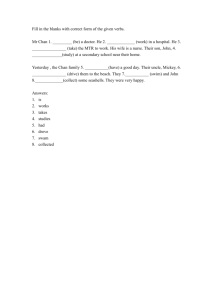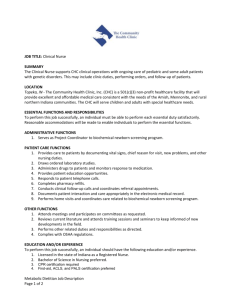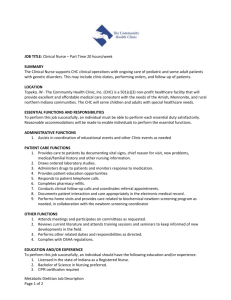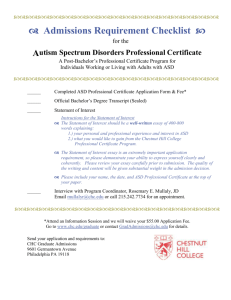PPT notes - Chu Hai College
advertisement
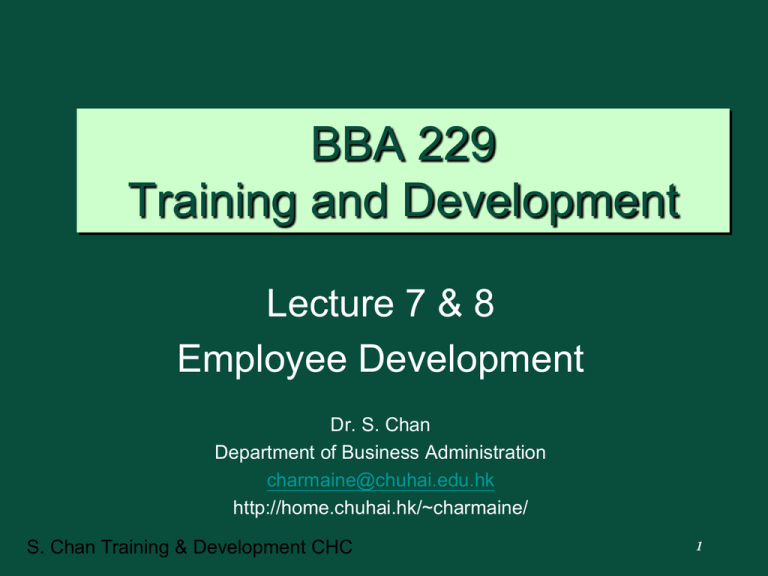
BBA 229 Training and Development Lecture 7 & 8 Employee Development Dr. S. Chan Department of Business Administration charmaine@chuhai.edu.hk http://home.chuhai.hk/~charmaine/ S. Chan Training & Development CHC 1 Employee Development Development refers to formal education, job experiences, relationships, and assessments of personality and abilities that help employees perform effectively in their current or future job and company. S. Chan Training & Development CHC 2 Comparison Between Training and Development S. Chan Training & Development CHC 3 Why is Employee Development Important? (1 of 2) Employee development is a necessary component of a company’s efforts to: – improve quality – retain key employees – talent management – meet the challenges of global competition and social change – incorporate technological advances and changes in work design S. Chan Training & Development CHC 4 Why is Employee Development Important? (2 of 2) Development activities can help companies reduce turnover: – by showing employees that the company is investing in the employees’ skill development – by developing managers who can create a positive work environment that makes employees want to come to work and contribute to the company goals S. Chan Training & Development CHC 5 Approaches to Employee Development -Formal Education -Assessment -Job Experience -Interpersonal Relationships S. Chan Training & Development CHC 6 Formal Education Formal education programs include: – off-site and on-site programs designed specifically for the company’s employees – short courses offered by consultants or universities – executive MBA programs – university programs in which participants actually live at the university while taking classes S. Chan Training & Development CHC 7 Trends in Executive Education Universities offer MBA programs that allow employees to earn the MBA in less than two years Universities offering executive education programs are beginning to measure their programs’ ROI Companies also provide tuition reimbursement to encourage employees S. Chan Training & Development CHC 8 Assessment Assessment involves collecting information and providing feedback to employees about their behavior, communication style, or skills Used most frequently to – identify employees with managerial potential – measure current managers’ strengths and weaknesses – identify managers with potential to move into higher-level executive positions – work with teams to identify members’ strengths and weaknesses, and factors that inhibit productivity S. Chan Training & Development CHC 9 Popular Assessment Tools Myers-Briggs Type Indicator® (MBTI) Assessment Center Benchmarks Performance Appraisals and 360-Degree Feedback Systems S. Chan Training & Development CHC 10 Assessment Tools: Myers-Briggs (MBTI) Most popular psychological test for employee development Used for understanding such things as: –communication –motivation –teamwork –work styles –leadership S. Chan Training & Development CHC 11 Personality Types Used in the MyersBriggs Type Indicator Assessment S. Chan Training & Development CHC 12 Personality Types Used in the Myers-Briggs Type Indicator Assessment (concluded) S. Chan Training & Development CHC 13 Examples of MBTI Use Can be used by salespeople who want to become more effective at interpersonal communication by learning things about their own personality styles and the way they are perceived by others Can help develop teams by matching team members with assignments that allow them to capitalize on their preferences Can help employees understand how the different preferences can lead to useful problem solving S. Chan Training & Development CHC 14 Assessment Tools: Assessment Center (1 of 2) A process in which multiple raters or evaluators evaluate employees’ performance on a number of exercises –usually held at an off-site location –used to identify if employees have the abilities, personality, and behaviors for management jobs –used to identify if employees have the necessary skills to work in teams S. Chan Training & Development CHC 15 Assessment Tools: Assessment Center (2 of 2) Types of exercises used include: – leaderless group discussions – interviews – in-baskets – role plays S. Chan Training & Development CHC 16 Examples of Skills Measured by Assessment Center Exercises S. Chan Training & Development CHC 17 Assessment Tools: Benchmarks An instrument designed to measure important factors in being a successful manager Items measured are based on research that examines the lessons executives learn at critical events in their careers This includes items that measure managers’ skills in dealing with: – subordinates – acquiring resources – creating a productive work climate S. Chan Training & Development CHC 18 Skills Related to Managerial Success Resourcefulness Doing whatever it takes Being a quick study Building and mending relationships Leading subordinates Compassion and sensitivity Straightforwardness and composure Setting a developmental climate S. Chan Training & Development CHC Confronting problem subordinates Team orientation Balance between personal life and work Decisiveness Self-awareness Hiring talented staff Putting people at ease Acting with flexibility 19 Assessment Tools: Performance Appraisals The process of measuring employees’ performance Approaches for measuring performance: – ranking employees – rating work behaviors – rating the extent to which employees have desirable traits believed to be necessary for job success (e.g., leadership) – directly measuring the results of work performance (e.g., productivity) S. Chan Training & Development CHC 20 Conditions in which Performance Measurement is useful for Development The appraisal system must give employees specific information about their performance problems and ways they can improve their performance Managers must be trained in providing performance feedback Managers must frequently give employees performance feedback Managers also need to monitor employees’ progress in carrying out the action plan S. Chan Training & Development CHC 21 Assessment Tools: 360-Degree Feedback System Peers Rating Form Rating Form Manager Self Customers Rating Form S. Chan Training & Development CHC Rating Form Subordinates 22 Development Planning Activities from 360-degree Feedback Process S. Chan Training & Development CHC 23 Factors necessary for a 360-degree feedback system to be effective: The system must provide consistent (reliable) ratings Feedback must be job-related (valid) The system must be easy to use, understandable, and relevant The system must lead to managerial development S. Chan Training & Development CHC 24 360-Degree Feedback: Important Issues to Consider Who will the raters be? How will you maintain the confidentiality of the raters? What behaviors and skills are job-related? How will you ensure full participation and complete responses from every employee who is asked to be a rater? What will the feedback report include? How will you ensure that managers receive and act on the feedback? S. Chan Training & Development CHC 25 Job Experiences To be successful in their jobs, employees must stretch their skills. They must be forced to learn new skills, apply their skills and knowledge in a new way, and master new experiences. Relationships, problems, demands, tasks, or other features that employees face in their jobs Most employee development occurs through job experiences A major assumption is that development is most likely to occur when there is a mismatch between the employee’s skills and past experiences and the skills required for the job S. Chan Training & Development CHC 26 Enlarging the Current Job Job enlargement – adding challenges or new responsibilities to an employee’s current job This could include: – special project assignments – switching roles within a work team – researching new ways to serve clients and customers S. Chan Training & Development CHC 27 Characteristics of Effective Job Rotation Systems (1 of 2) Job rotation is used to develop skills as well as give employees experience needed for managerial positions Employees understand specific skills that will be developed by rotation Job rotation is used for all levels and types of employees All employees have equal opportunities for job rotation assignments S. Chan Training & Development CHC 28 Characteristics of Effective Job Rotation Systems (2 of 2) Job rotation is linked with the career management process so employees know the development needs addressed by each job assignment Benefits of rotation can be maximized and work load costs minimized through managing time of rotations. This can help employees understand job rotation’s role in their development plans S. Chan Training & Development CHC 29 Transfers, Promotions, and Downward Moves Transfer - in a transfer, an employee is given a different job assignment in a different area of the company Promotions – advancements into positions with greater challenges, more responsibility, and more authority than in the previous job Downward move – occurs when an employee is given a reduced level of responsibility and authority S. Chan Training & Development CHC 30 Interpersonal Relationships Employees can also develop skills and increase their knowledge about the company and its customers by interacting with a more experienced organizational member Two types of interpersonal relationships used to develop employees: – mentoring – coaching S. Chan Training & Development CHC 31 Characteristics of Successful Formal Mentoring Programs (1 of 2) Mentor and protégé participation is voluntary – relationship can be ended at any time without fear of punishment Mentor-protégé matching process does not limit the ability of informal relationships to develop Mentors are chosen on the basis of: – their past record in developing employees – willingness to serve as a mentor – evidence of positive coaching, communication, and listening skills S. Chan Training & Development CHC 32 Characteristics of Successful Formal Mentoring Programs (2 of 2) The purpose of the program is clearly understood The length of the program is specified A minimum level of contact between the mentor and protégé is specified Protégés are encouraged to contact one another to discuss problems and share successes The mentor program is evaluated Employee development is rewarded S. Chan Training & Development CHC 33 Benefits of Mentoring Relationships (1 of 2) Mentors provide – career support – psychosocial support Benefits for protégés: – skill development – higher rates of promotion – larger salaries – greater organizational influence S. Chan Training & Development CHC 34 Benefits of Mentoring Relationships (2 of 2) Provide opportunities for mentors to: – develop their interpersonal skills – increase their feelings of self-esteem and worth to the organization – gain knowledge about important new scientific developments in their field S. Chan Training & Development CHC 35 Coaching Relationships (1 of 2) Coach – a peer or manager who works with employees to motivate them help them develop skills provide reinforcement and feedback The best coaches are: – – – – empathetic supportive practical self-confident They also do not appear to know all the answers S. Chan Training & Development CHC 36 Coaching Relationships (2 of 2) Three roles that a coach can play: – one-on-one with an employee, providing feedback based on psychological tests, 360-degree assessment, or interviews with bosses, peers, and subordinates – help employees learn for themselves by putting them in touch with experts who can help them with their concerns and by teaching them how to obtain feedback from others – provide the employee with resources such as mentors, courses, or job experiences that the employee may not otherwise have access to S. Chan Training & Development CHC 37
